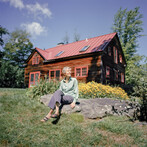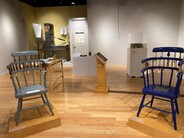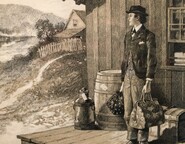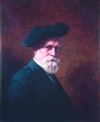Past Exhibits at the Museum
Fairbanks Scales: Weighing the World
January 2024-July 2024, National Life Gallery, Vermont History Museum, Montpelier
The exhibit explores how a large scale led to large-scale changes to how the world does business, and changed the course of the history of St. Johnsbury, VT.
In the early 1800s, the Fairbanks brothers had a problem and Thaddeus came up with a solution. His platform scale innovation allowed for wagon loads of materials to be weighed without unloading. The concept was an overnight success and soon the Fairbanks Scale Co. was making scales to weigh everything from a piece of paper to a locomotive. The exhibit features a number of scales, alongside photographs, documents, and ephemera that tell this core St. Johnsbury story.
A Stitch in Time
July 2023-June 2024, National Life Gallery, Vermont History Museum, Montpelier
We all know the phrase “History repeats itself.” We hear it applied to politics, wars, and large social movements, but what about the small things?
In our rotating exhibit, A Stitch in Time, the Vermont Historical Society will explore how your fashion choices today are informed by the fashions of history. Each rotation will feature two historical garments from the collection and one modern garment, showing that there's really no such thing as a new, original trend—all modern fashions are inspired and informed by history.
This exhibit featured three different rotations: examining the new trend of luxury loungewear, the evolution of ski boots and equipment, and the evolution of nursing uniforms.
Calvin Coolidge: America's President
July 2023-June 2024, Calder Gallery, Vermont History Museum, Montpelier
August 2023 marks the centennial of Calvin Coolidge’s arrival in the oval office, following the death of President Warren G. Harding. To explore the legacy of his life and administration, the Vermont Historical Society is hosting an exhibition from the Calvin Coolidge Presidential Foundation, which tells the story of Coolidge’s life and work in an innovative graphic exhibit.
Calvin Coolidge: Vermont’s President will be displayed in the Vermont History Museum’s Jackie Calder Exhibit Gallery, and features specially commissioned graphic illustrations of key moments in Coolidge’s career, accompanied by text explaining the context and impact of those moments. Artist Paul Rivoche (The Forgotten Man: A New History of the Great Depression) provided the illustrations for the exhibit.
Visitors will also be able to learn more about the famously reserved President’s communications style – through text, audio, and art – and offer their own ideas on his impact and legacy.
Fancy Goods: Hats and Fasion Accessories, 1850-1950
July 2023-January 2024, Local History Gallery, Vermont History Museum, Montpelier
Fancy goods were designed to appeal to taste or fancy rather than what was essential. The primarily ornamental fashion items in this exhibit document what residents of Middletown Springs considered fancy goods. The approximately 30 items, which date from 1850 to 1950, were donated to the Middletown Springs Historical Society collection by local families.
A New American Globe: James Wilson of Vermont
July 2022-June 2023, National Life Gallery, Vermont History Museum, Montpelier
James Wilson of Bradford created the first commercially available globes in America. Beginning in 1810, he produced and sold terrestrial and celestial globes for home and classroom use, advertising them as superior American-made products. Wilson's path to globemaking was far from obvious, and he has been celebrated as a unique Vermont genius.
How much of what we know about him is anecdotal and hearsay, and how much is based in close examination of quality archival sources?
Vermonters at Work
January 2023-July 2024, Local History Gallery, Vermont History Museum, Montpelier
Vermonters at Work exhibition tells the story of the inventiveness and energy that Vermonters have always put into their daily work life. The exhibit features antique tools and machinery, 19th-century printed advertisements for Vermont farm inventions, early photos, and paintings of Vermonters at work on the landscape. These artifacts tell many stories about using the land well and making daily chores more efficient and help the viewer understand what people needed to get the work done. It reminds us that while we've come a long way in the last century technologically, Vermont has always been a place brimming with invention, independence, and hard work.
The exhibit is a collaboration between Jan Blomstrann, the retired co-founder and former owner of NRG Systems, and Sarah-Lee Terrat, a fine artist and designer from Waterbury. Their partnership in this project began in 2000 when Blomstrann contacted Terrat to create custom installation artwork for NRG’s LEEDS-certified headquarters in Hinesburg. While combing through art galleries, antique shops, and flea markets, Terrat was attracted to artifacts and printed pieces that told the story of an earlier era of Yankee ingenuity, and how Vermonters devised solutions to their most pressing problems on the working landscape.
The Vermont Common Cracker
July 2022-January 2023, Local History Gallery, Vermont History Museum, Montpelier
For just about the entire 19th century the simple common cracker was an important staple of the northern New England diet. Though often described as dry and tasteless, many old time Vermonters enjoyed a Sunday night crackers and milk fix. It carried many names, such as the Montpelier Cracker, Cross Cracker, St. Johnsbury Cracker, and just plain old Vermont Cracker. Common Cracker-The Exhibit explores the fascinating history of just what a common cracker is, how they were made, advertised and sold, and the many Vermont bakeries that produced them. Created by the Montpelier Historical Society.
The Catamount in Vermont
July 2021-July 2022, National Life Gallery, Vermont History Museum, Montpelier
The catamount has long been a symbol of Vermont. This new exhibit explores the history of the catamount through the lenses of art, science, and culture.
The Voices of St. Joseph's Orphanage
February 2022-July 2022, Local History Gallery, Vermont History Museum, Montpelier
The St. Joseph’s Orphanage in Burlington was home to more than 13,000 children from 1854 to1974. Although the Catholic-run institution was held in high regard in the community, accounts began to emerge in the 1990s from scores of former orphanage residents describing abuse at the hand of nuns and other clerical personnel. Few were believed at first, but these ex-orphans persevered, ultimately winning validation for the harm done to them and working for laws protecting vulnerable children in Vermont. This is the story of these former orphans, now known as the Voices of St. Joseph, and their remarkable and enduring accomplishments.
WPA prints from the T.W. Wood Gallery
July 2020-March 2021, Local History Gallery, Vermont History Museum, Montpelier
The T. W. Wood Gallery is the repository for Vermont's portion of the Federal WPA collection. In addition to a variety of laborers, over 40,000 artists and other talented workers were employed through the WPA in the United States for art, music, theatre, and literature projects.
When Women Lead
July 2020-Spring 2021, National Life Gallery, Vermont History Museum, Montpelier
Over fifty years post women's suffrage, a Vermont governor, not a first lady, wore a gown to an inauguration.
Throughout her career, former Vermont Governor, Madeline Kunin, broke this and many other barriers for women in politics. Governor Kunin recently donated her three inaugural gowns to the Vermont Historical Society. They are on view, alongside an exploration of Kunin's life and political career, in the National Life Gallery at the Vermont History Museum.
Clothing and textiles can be richly symbolic objects, and Kunin’s gowns are no exception. Clothing worn to public events by female politicians is still a subject of intense interest and debate. Kunin put it succinctly: “When women lead, they have to think about what to wear.”
 The Dames
The Dames
February-July 2020, Local History Gallery, Vermont History Museum, Montpelier
For many people, ancestral lineage organizations such as the Colonial Dames are a world apart. We might be intrigued by their celebration of family and colonial history, patriotic service, and shared values—or, alternately, made uncomfortable by perceptions of elitism surrounding their lineage-based membership. But who are these women—these Dames? This exhibit is a collection of oral history recordings and photographic portraits created by the Vermont Folklife Center featuring thirteen members of the National Society of Colonial Dames of America in the State of Vermont.
 The Sheldon Relic Chair, 1884-2018
The Sheldon Relic Chair, 1884-2018
February-July 2020, Local History Gallery, Vermont History Museum, Montpelier
In the 1880s, Middlebury resident Henry Luther Sheldon began constructing an eclectic “Memorial Chair,” with each of the spindles in the top two rows carved from “relics”— fragments from sites of historical significance, from the Middlebury Congregational Church to the ship Old Ironsides. In this way, the chair is a material object that embodies local and national history. In January 2018, students from Middlebury College researched this chair, and nineteenth-century collecting practices, then went about creating a 2018 version (using items such as College President Laurie Patton’s earbuds, bike handlebars, and a piece of marble from Marble Works). The two chairs now offer a dialogue about practices of craft and memory-making in 1884 and 2018.
A Footpath in the Wilderness: The History of the Long Trail
November 2019, Calder Gallery, Vermont History Museum, Montpelier
When James P. Taylor first advanced the idea of a wilderness hiking trail through Vermont’s Green Mountains, his vision was as expansive as the landscape itself. People would come to Vermont, fall in love with the trail and the mountains, and grow to love and support the state itself. To that end, he and twenty-two others founded the Green Mountain Club (GMC).
The newly-formed Green Mountain Club intended to build a hiking footpath from Massachusetts to Canada. Construction began in 1912, and the first completed section ran from Sterling Pond to Camel’s Hump. Over the next ten years, GMC members and other volunteers constructed an additional 209 miles and raised 44 trail shelters. In 1930, trailblazers cut the final link of the Long Trail from Jay Peak to the Canadian border.
Over the years, the trail underwent a series of reroutes in some areas to lift it from lower elevations to the high ridgeline. Work continues today to upgrade or relocate the trail to more suitable locations or onto conserved lands. Through all the trail changes, the experience of hiking on the Long Trail remains a timeless and meaningful endeavor.
 Vermont’s Historical Brand
Vermont’s Historical Brand
April 2019-July 2020, National Life Gallery, Vermont History Museum, Montpelier
From 1934 to 1946, the National Life insurance company commissioned 150 works of art depicting stories from Vermont's past. These illustrations, and associated Vermont stories used to pitch various insurance products, appeared in such popular publications as The Saturday Evening Post, Time, Colliers, and The Atlantic. The set of illustrations became so popular that National Life published them in book form for Vermont schools to use. This exhibit includes 14 of the original works of art created for these campaigns by artists Roy F. Heinrich and Herbert M. Stoops, along with the original descriptions meant to accompany them. Works on loan from, and exhibit made possible by, National Life.
 Norman Rockwell's Arlington: America's Home Town
Norman Rockwell's Arlington: America's Home Town
August 2019 to February 2020, Local History Gallery, Vermont History Museum, Montpelier
From roughly 1920 to 1960, Arlington was the center of an influential community of artists whose work shaped our image of America. Led by Norman Rockwell, these artists produced hundreds of illustrations for major magazines like The Saturday Evening Post, ads for major corporations and influential public service campaigns. Norman Rockwell's Arlington: America's Home Town chronicles Rockwell and the other artists who lived in Arlington, as well as the many local residents who posed for the scenes of everyday life they portrayed. Some of the most iconic images we know of life in America were in fact, portraits of Arlington's citizens.
 Sports in Vermont
Sports in Vermont
May to November 2019, Calder Gallery, Vermont History Museum, Montpelier
Borrow this exhibit! Available through our Traveling Exhibit program
Vermonters are active and athletic, and find ways to enjoy sports regardless of the weather. In the mountains and in the valleys, inside and out, over the decades the thrill of victory and the agony of defeat has been part of life in the Green Mountain State. Sports in Vermont explores the way Vermonters enjoy pastimes both competitively and for fun, in all four seasons.
 Vermont Music Far and Wide
Vermont Music Far and Wide
January to July 2019, Local History Gallery, Vermont History Museum, Montpelier
Vermont’s music spans genres and generations and reminds us how creative and diverse we are as a people, past and the present. The volunteer-staffed nonprofit Big Heavy World has curated a colorful and interactive exhibit of eclectic artifacts that showcase Vermont music history from recent decades. ‘Vermont Music, Far & Wide’ reflects on how music is an art form, a catalyst for community-building, and also a contributor to the state’s economy.
 Seeds of Renewal
Seeds of Renewal
October 2018 to May 2019, Calder Gallery, Vermont History Museum, Montpelier
Borrow this exhibit! Available through our Traveling Exhibit program
The Seeds of Renewal exhibition was created in 2018 by the Vermont Historical Society in partnership with Dr. Frederick M. Wiseman, an Abenaki community member and retired professor and department chair of humanities at Johnson State College. The exhibit includes panels exploring Abenaki agricultural history and techniques, varieties of indigenous Abenaki plants, agricultural ceremony and harvest dinners, and cooking techniques. It also includes models of indigenous squash varieties, examples of different types of indigenous corn, and recipes. The exhibit aims to raise awareness of Abenaki agricultural history, cuisine, and ceremony, and how one can play an active role in Indigenous cultural awareness and revitalization.
 Brattleboro, the Defining Decades: 1870-1920
Brattleboro, the Defining Decades: 1870-1920
July 2018 to January 2019, Local History Gallery, Vermont History Museum, Montpelier
Brattleboro’s central New England location has been attractive to people throughout history. And one particular period of time shaped the town rather dramatically. Brattleboro - The Defining Decades showcases Brattleboro from 1870-1920, when the Main Street we recognize today began to take form, industry and commerce expanded, and arts and culture began to flourish. Explore the growth of this southeastern Vermont town through maps, photos, and other items from the Brattleboro Historical Society collection.
 Solzhenitsyn in Vermont
Solzhenitsyn in Vermont
May 2018 to November 2018, Calder Gallery, Vermont History Museum, Montpelier
Borrow this exhibit! Available through our Traveling Exhibit program
The Solzhenitsyn in Vermont exhibit celebrates the life and work of Russian novelist and historian Aleksandr Solzhenitsyn, particularly his time living in Cavendish, Vermont and its influence on his life and work. Telling the story through photographs, quotes, and family memories, the exhibit includes 5 main exhibit panels, along with 4 timeline panels noting important moments from Solzhenitsyn’s life.
 Our Vanishing Landmarks: Chelsea and Beyond
Our Vanishing Landmarks: Chelsea and Beyond
January 2018 to July 2018, Local History Gallery, Vermont History Museum, Montpelier
Photographs and pen & ink drawings tell the story of old wooden barns, farm buildings, and equipment from the Chelsea, VT area that are slowly disappearing from the landscape but were an essential part of existence and survival for the early farmers in the mountains of Vermont.
 Everywhere a Sign
Everywhere a Sign
December 2017 to May 2018, Calder Gallery, Vermont History Museum, Montpelier
Currently on display at the Vermont History Center, Barre
Borrow this exhibit! Available through our Traveling Exhibit program
Signs are everywhere. They inform, educate and promote. Over time, many signs become a part of their communities. They are a way to orient visitors or a source of shared memory. The Vermont Historical Society’s travelling exhibit “Everywhere a Sign” examines the distinct and diverse roles signs play in our everyday. Through images and text, you can explore the progression from colonial-era signs that utilized symbols as a common language, to the digital signs of today that can change their message every minute. The diversity, artistry and impact of signs on our everyday lives are immeasurable. What sign will you notice next?
 Family Traits
Family Traits
November 2017 to January 2018, Local History Gallery, Vermont History Museum, Montpelier
“Family Traits,” created by the Vermont Folklife Center, tells the story of Stanley Lyndes and the impact he had on his family and the collective memories they share. Stanley channeled his noticing into the making of things, and over time these objects became touchstones for the generations of his family that have followed him, revered as both treasured artifact and the creative expression of a common past.
 Studies in Perfection: The Portrait Painting of Thomas Waterman Wood
Studies in Perfection: The Portrait Painting of Thomas Waterman Wood
August 2017 to November 2017, Local History Gallery, Vermont History Museum, Montpelier
Exploring some of the portrait work by renowned Montpelier painter T.W. Wood in an examination of his changing technique and talent, with a focus on comparing portraits of local Montpelier citizens with his master copies after Rembrandt and other European masters.
 The Morgan Horse in Vermont
The Morgan Horse in Vermont
April 2017 to August 2017, Local History Gallery, Vermont History Museum, Montpelier
Exploring the Morgan Horse and its ties to Vermont, from the time of Justin Morgan and "Figure" the first Morgan Horse, to today.